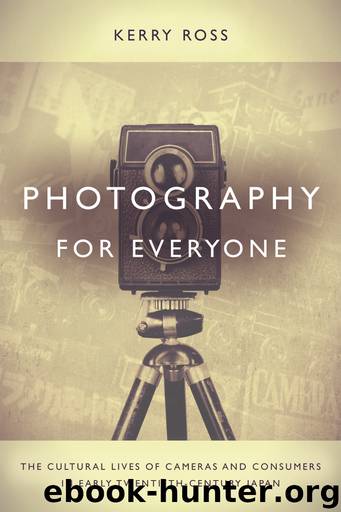Photography for Everyone by Ross Kerry

Author:Ross, Kerry [Ross, Kerry]
Language: eng
Format: epub
Publisher: Stanford University Press
Published: 2015-03-14T04:00:00+00:00
FIGURE 5.1 Readers’ winning submissions for Asahi kamera Monthly Photo Competition, Division One, April 1928. Judges favored the lyrical and expressionist styles of geijutsu shashin in 1928. Source: Asahi kamera 5, no. 4 (April 1928): 373.
FIGURE 5.2 Readers’ winning submissions for Asahi kamera Monthly Photo Competition, Divisions Two and Three, September 1938. Judges shift toward photographs using realistic depiction by 1938. Source: Asahi kamera 26, no. 3 (September 1938): 533.
The Modernist Attack on the Aesthetics of Geijutsu Shashin
In May 1926, Murayama Tomoyoshi, one of the premier figures of the avant-garde group Mavo, described the relationship of the avant-garde image and everyday life in an article for Asahi kamera, “The New Function of Photography.”14 In this short article, Murayama delineates four recent photographic trends, each of which he characterizes by the work of four photographers: Emil Otto Hoppé (1878–1972), Francis Bruguière (1879–1945), Man Ray (1890–1976), and El Lissitzky (1890–1941). While each of these artists exemplifies a specific trend in photography, Murayama is most interested in demonstrating whether these trends operate as socially engaged art forms and can thus take photography into the future on its own terms. For Murayama, Hoppé’s work is the least engaged and El Lissitzky’s work is the most. For our purposes, Murayuama’s negative appraisal of Hoppé is most illustrative. Hoppé’s work was extremely well received and well known in Japan. Fukuhara Shinzō arranged the first Japanese exhibition of Hoppé’s photographs in 1923, and Hoppé’s work was much touted in the 1927 International Photography Salon held in Tokyo by the Asahi Newspaper Company. According to Murayama, artists like Hoppé regard the camera as a machine that almost magically turns reality into art (genjitsu wo “geijutsu-ka”).15 For these artists, the camera is a tool that enables the artist to “create” art. A photograph cannot stand on its own terms but must be willed into art. The manipulation of such techniques as the soft-focus lens and textured papers, however, forces the geijutsu shashin photographer to misrepresent reality. Thus, such an approach, by far the most popular approach for hobbyists, has no relationship to everyday life. The most valuable contribution this kind of photography offers is its ability to comfort and amuse viewers, especially in the form of portraiture: “I can only think of geijutsu shashin in which reality is misrepresented simply by a soft-focus lens, or in which shadows are arranged so that the horizon line is placed higher than usual, as somehow extremely trifling. If one were to see this [style] as a painting, it would be an impressionist painting.”16
Even more biting was Ina Nobuo’s attack on geijutsu shashin. Ina, an editor of Kōga and leading high-modernist theorist of photography, wrote the now canonical article “Return to Photography,” published in the inaugural issue of Kōga in May 1932. Ina’s manifesto calls for photographers to “break away from art photography! . . . To break free from every conception of art and to destroy all idols!”17 In trying to make photography into art, hobby photographers rely on—imitate—other art forms, most notably painting.
Download
This site does not store any files on its server. We only index and link to content provided by other sites. Please contact the content providers to delete copyright contents if any and email us, we'll remove relevant links or contents immediately.
| Africa | Americas |
| Arctic & Antarctica | Asia |
| Australia & Oceania | Europe |
| Middle East | Russia |
| United States | World |
| Ancient Civilizations | Military |
| Historical Study & Educational Resources |
The Sympathizer by Viet Thanh Nguyen(4099)
The Rape of Nanking by Iris Chang(4025)
World without end by Ken Follett(3347)
Ants Among Elephants by Sujatha Gidla(3282)
Blood and Sand by Alex Von Tunzelmann(3061)
Japanese Design by Patricia J. Graham(3006)
City of Djinns: a year in Delhi by William Dalrymple(2438)
Foreign Devils on the Silk Road: The Search for the Lost Treasures of Central Asia by Peter Hopkirk(2389)
Inglorious Empire by Shashi Tharoor(2349)
The Queen of Nothing by Holly Black(2326)
India's Ancient Past by R.S. Sharma(2307)
In Order to Live: A North Korean Girl's Journey to Freedom by Yeonmi Park(2305)
Tokyo by Rob Goss(2295)
India's biggest cover-up by Dhar Anuj(2251)
Tokyo Geek's Guide: Manga, Anime, Gaming, Cosplay, Toys, Idols & More - The Ultimate Guide to Japan's Otaku Culture by Simone Gianni(2244)
The Great Game: On Secret Service in High Asia by Peter Hopkirk(2231)
Goodbye Madame Butterfly(2164)
Batik by Rudolf Smend(2010)
Living Silence in Burma by Christina Fink(1988)
